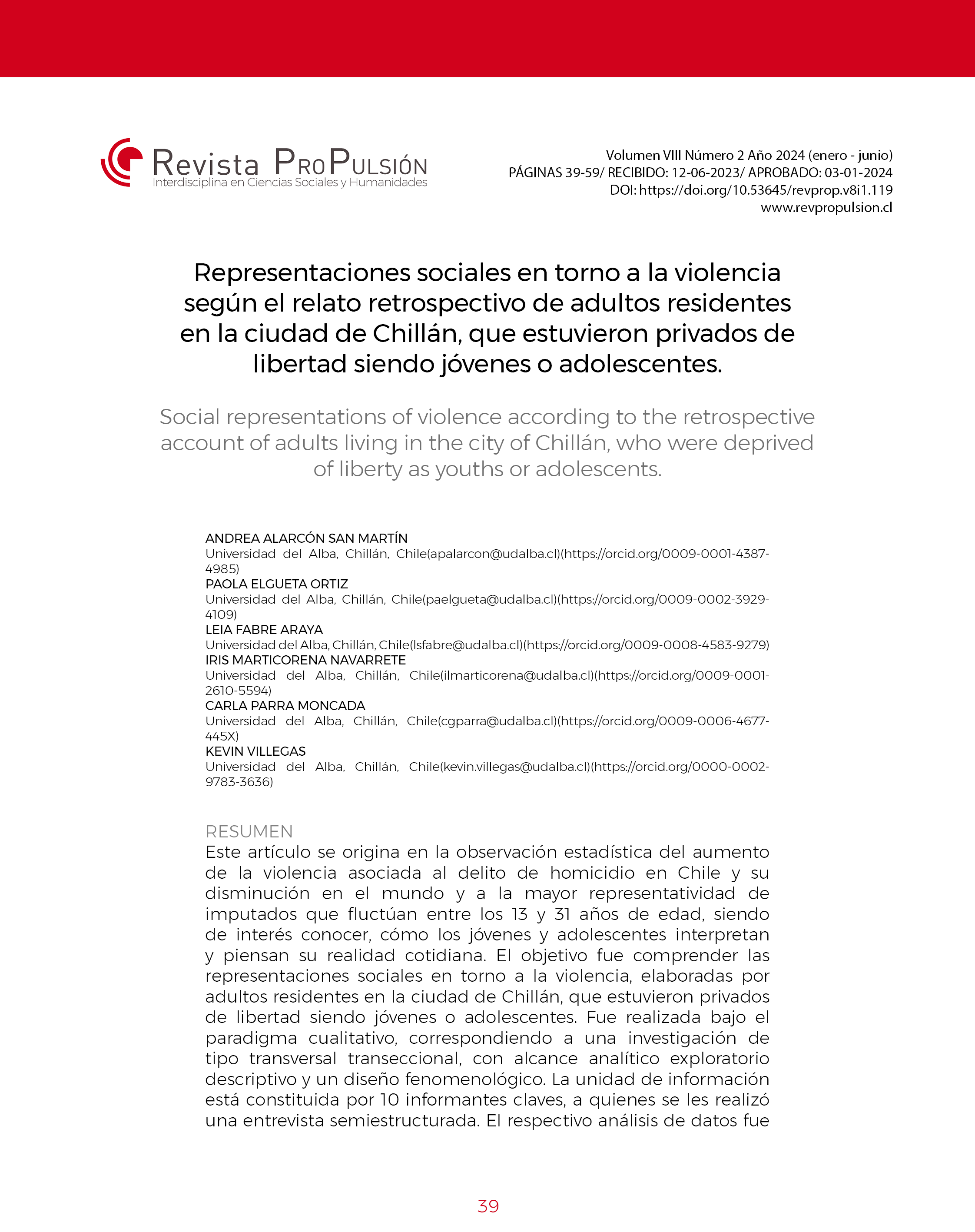Social representations of violence according to the retrospective account of adults living in the city of Chillán, who were deprived of liberty as youths or adolescents
DOI:
https://doi.org/10.53645/revprop.v8i1.119Keywords:
Social representations, self-perception, identity, adolescents, violenceAbstract
This article originates in the statistical observation of the increase of murder violence in Chile and its decrease in the world, associated to the greater representation of accused persons between 13 and 31 years of age, being of interest to know how young people and adolescents interpret and think their daily reality. The objective was to understand the social representations about violence, elaborated by adults residing in the city of Chillán, who were deprived of liberty as youths or adolescents. It was conducted under the qualitative paradigm, corresponding to cross-sectional research, with a descriptive exploratory analytical scope and a phenomenological design. The unit of information consisted of 10 volunteers who underwent a semi-structured interview, and the analysis was carried out according to Sergio Martinic's structural semantics. The results indicate that maternal abandonment, the father's violence that was normalized and the lack of support from a responsible adult contributed to seek and find safe bonds in the gang, a space in which emotional decontrol was normalized. Emotional control was regained upon deprivation of liberty. They presented a deteriorated identity and at the same time a positive self-perception. The conclusions determined as conditioning elements of the information on violence with which they interpret reality, maternal abandonment, paternal intrafamilial violent domination, a deteriorated identity, and a positive self-perception
Downloads
References
Agudelo L., Gómez, J., López, A., de los Ríos, A., Quintero, J., Álvarez , T., Vélez, B., y Castañeda, G., (2007). Representaciones sociales: otra perspectiva de estudio de la violencia. Revista Colombiana de Psiquiatría, XXXVI(2), 224-236. https://www.redalyc.org/pdf/806/80636206.pdf.
Banco Mundial, (2023). Base de datos de estadísticas de homicidios internacionales de la Oficina de las Naciones Unidas contra la Droga y el Delito. https://datos.bancomundial.org/indicator/VC.IHR.PSRC.P5
Beck, B., Zusevics, K., y Dorsey, E. (2019). Why urban teens turn to guns: urban teens' own words on gun violence. Public health, 177, 66–70. https://doi.org/10.1016/j.puhe.2019.06.020
Carvacho,P y Rufz,C (2023). Datos en Perspectiva, Series sobre la Criminalidad en Chile. Pontificia Universidad Católica de Chile. https://justiciaysociedad.uc.cl/wp-content/uploads/2023/01/DEP-SERIE-1_Series-sobre-criminalidad_V3.pdf
Callejas Fonseca, L., & Piña Mendoza, C. (2005). La estigmatización social como factor fundamental de la discriminación juvenil. El Cotidiano (134), 64-70. https://www.redalyc.org/articulo.oa?id=32513409
Colegio de Psicólogos de Chile. (1999). Código de ética profesional. Santiago: Comisión Asesora Técnica. http://colegiopsicologos.cl/wp-content/uploads/2021/06/1999-Codigo-de-Etica-2a-Edicion.pdf
Cruz, F. (2006). Género, psicología y desarrollo rural: las representaciones sociales de las mujeres en el medio rural. https://www.mapa.gob.es/ministerio/pags/biblioteca/fondo/pdf/87506_all.pdf
Cuervo, K., Villanueva, L., Born, M., & Gavray, C. (2017). Analysis of Violent and Non-violent Versatility in Self-reported Juvenile Delinquency. Psychiatry, psychology, and law: an interdisciplinary journal of the Australian and New Zealand Association of Psychiatry, Psychology and Law, 25(1), 72–85. https://doi.org/10.1080/13218719.2017.1347935
Goffman, E. (2001) Internados: Ensayos sobre la situación social de los enfermos mentales. Argentina, Amorrortu. https://fundacion-rama.com/wp-content/uploads/2023/01/1638.-Internados.-Ensayos-sobre-la-%E2%80%A6-Goffman.pdf
Fernández, L. (2006). ¿Cómo analizar datos cualitatitvos? Barcelona: Butlletí La Recerca. https://ebevidencia.com/wp-content/uploads/2014/12/analisis-datos-cualitativos.pdf
Link, B., y Phelan, J. (2001). Conceptualizing stigma. Annual Review of Sociology, 27, 363–385. https://doi.org/10.1146/annurev.soc.27.1.363
González, P. y Ortegón, L. (2021). Representaciones sociales de un grupo de adolescentes frente al reconocimiento titularidad y garantía de sus derechos sexuales y reproductivos. https://ciencia.lasalle.edu.co/cgi/viewcontent.cgi?article=2243&context=trabajo_social
Hernández, R., Fernández, C., & Baptista, M (2014). Metodología de la Investigación. México: McGraw-Hill
Hernández, R., Peña, A., & Rubiano, Y. (2006). Representaciones sociales de interrelaciones familiares de escolares: factores generadores de violencia, Revista Orinoquia, Universidad de los Llanos,Villavicencio, Meta, Colombia, Volumen 10 (2), 69-78. https://www.redalyc.org/articulo.oa?id=89610209
Jodelet, D. (1986 [1984]). La representación social: fenómenos, concepto y teoría. En: S. Moscovici. Psicología social. Vol. II. Editorial Paidós, Buenos Aires. https://www.researchgate.net/publication/327013694_La_representacion_social_fenomenos_concepto_y_teoria
Krause, M., Tourche, P., Velásquez,E., & Jaramillo,A (2014). Social representations of violence among young involved in violence. Revista Psicoperspectiva, individuo y Sociedad, Universidad Católica de Chile, Volumen 13(2), 55-66. https://www.psicoperspectivas.cl/index.php/psicoperspectivas/article/viewFile/384/336
Kelly, S., Anderson, D., Hall, L., Peden, A., & Cerel, J. (2012). The effects of exposure to gang violence on adolescent boys' mental health. Issues in mental health nursing, 33(2), 80–88. https://doi.org/10.3109/01612840.2011.623217
Maldonado, F. (2013). Prevalencia de patologías de salud mental en la población adolescente privada de libertad: Experiencias nacionales y comparadas. Ius et Praxis, 19(1), 329-362. https://www.scielo.cl/scielo.php?script=sci_arttext&pid=S0718-00122013000100010
Martín, M.-J., Martínez, J.-M., Aramayona, B., García-Sánchez, R., Almendros, C., & Jiménez, C. (2016). Jóvenes pertenecientes a grupos violentos en la Comunidad de Madrid. Modelo psicosocial procesual sobre el inicio y la evolución de la conducta violenta identitaria. Anales de Psicología / Annals of Psychology, 33(1), 120–132. https://doi.org/10.6018/analesps.33.1.228541.
Martínez, A., (2016). La violencia. Conceptualización y elementos para su estudio. Política y Cultura, (46), 7-31. https://www.redalyc.org/articulo.oa?id=26748252001
Martinic S.(1992). ANALISIS ESTRUCTURAL: Presentación de un método para el estudio de lógicas culturales. Centro de investigación y desarrollo de la investigación. https://repositorio.uahurtado.cl/bitstream/handle/11242/8291/6528.pdf?sequence=1&isAllowed=y
Mella, O. (1998). Naturaleza y Orientaciones teórico-Metodológicas de la investigación cualitativa. https://repositorio.uahurtado.cl/bitstream/handle/11242/8356/8434.pdf?sequence=l
Moraes, D. (2007). Imaginario Social, cultura y construcción de la hegemonía. Contratiempo; Revista de Cultura y pensamiento, VOL: 2. http://www.revistacontratiempo.%20com.ar/moraes_imaginario_cultura_hegemonia.htm
Moya, A., Bernal,M. Blasco,C.Costa,R., González,E., Herrero,N., Martín,J., Martínez,M., Mesa,P., Polderman,T., Rebollo, I., Romero,A. Fernández,A. & Serrano,M. (2020). Neurocriminología, Ediciones Pirámide, Madrid.
Moscovici, S. (1979 [1961]). El psicoanálisis, su imagen y su público. Huemul S.A., Buenos Aires. (1988). https://taniars.files.wordpress.com/2008/02/moscovici-el-psicoanalisis-su-imagen-y-su-publico.pdf
Nicolodi P, Espinosa I y Honores R .(2021). Informe Estadístico de homicidios en Chile . Ministerio Público de Chile. http://www.fiscaliadechile.cl/Fiscalia/Informe_homicidios_2021_final.pdf
Ortega, M. y Liloff, G. (2020). Las representaciones sociales de la violencia: el caso Fernando Báez a través del análisis lexicométrico de la prensa digital en Facebook. Revista de Investigación del Departamento de Humanidades y Ciencias Sociales, núm. 17, pp. 63-85. Universidad Nacional de La Matanza.https://www.redalyc.org/journal/5819/581963108004/html/
Puello, L. y Domínguez, E. (2019). Representaciones sociales acerca de la violencia de género en jóvenes residentes en los barrios Bicentenario y Olaya Herrera. Tesis de grado. Universidad Tecnológica de Bolívar. https://biblioteca.utb.edu.co/notas/tesis/0074733.pdf
Reichardt, Ch., & Cook, T. (1986) Métodos cualitativos y cuantitativos en una investigación evaluativa. Madrid: Ediciones Morata. https://www.uv.mx/mie/files/2012/10/Metodoscualitativosycuantitativosdeinvestigacion.pdf
Villanueva, J., Jaramillo, M., Sotomayor, E., Gutiérrez, C., & Torres, A. (2018). La salud mental en los modelos de atención de adolescentes infractores. Los casos de Colombia, Argentina, Estados Unidos y Canadá. Revista Universitas Médica, 59, 1-17 http://www.scielo.org.co/scielo.php?script=sci_arttext&pid=S2011-08392018000400017
Vicente, B., Saldivia, S., De la Barra, F., Melipillán, R., Valdivia, M., & Kohn, R. (2012). Prevalence of psychiatric disorders among Chilean children and adolescents. Revista Médica de Chile, 140(4), 447-44757. https://repositorio.uchile.cl/bitstream/handle/2250/161845/art05.pdf?sequence=3&isAllowed=y
Viejo Almazor, C. (2012). Dating violence y cortejo adolescente. Un estudio sobre la violencia en las parejas sentimentales de los jóvenes andaluces. Servicio de Publicaciones de la ciudad de Córdoba. https://helvia.uco.es/xmlui/handle/10396/7642

Published
How to Cite
Issue
Section
Categories
License
Copyright (c) 2024 kevin villegas

This work is licensed under a Creative Commons Attribution-NonCommercial 4.0 International License.
- Esta licencia permite a los reutilizadores distribuir, remezclar, adaptar y construir sobre el material en cualquier medio o formato solo con fines no comerciales, y solo mientras se dé atribución al creador.Incluye los siguientes elementos: POR – Se debe dar crédito al creador NC – Solo se permiten usos no comerciales de la obra.







